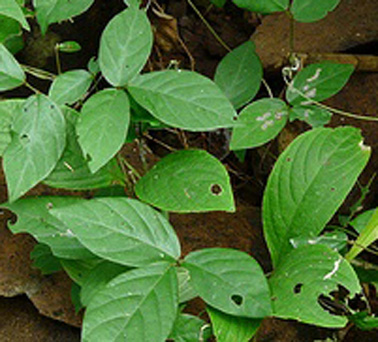|
Botanical Name:
Teramnus labialis
Masparni consists of dried whole plant of Teramnus labialis
Spreng, Family Fabaceae
Common Name(s) in English & Indian Languages
Sanskrit: Mahasaha, Suryasani, Kamboj, Pandutomasa Pasni
Bengali: Mashance, Bankalaai, Mashani
English: Vogel-Tephrosis
Guajarati: Banudad, Janglee, Adad
Hindi: Mashvan, Banvdad, Mashoni
Kannada: Kadu Uddu
Malayalam: Katu Ulandu
Marathi: Ran Udid
Punjabi: Jangali Urad
Tamil: Kattu-Ulandu
Telugu: Karuminum, Mashperni
Botanical description:
A widely spreading twining hairy herb with stems slender.
Leaves 3-foliate, leaf-lets membranous or sub-coriaceous,
3.5 – 6 x 1.5 – 2.5 cm, the terminal slightly the largest,
ovate-oblong or oblong – lanceolate, hairy beneath, base
rounded or acute, stipels subulate, stipules ovate –
lanceolate, deciduous. Flowers reddish, bisexual, in
axillary few flowered lax racemes, 5-15 cm long, solitary or
fascicled along a slender, more or less hairy rachis. Pods
3-5 cm long, narrowly linear, straight or slight incurved,
hairy when young, glabrous on maturity with a short stout
beak bent upwards nearly at right angle with the pod. Seeds
8-12, oblong, truncate or slightly rounded at the ends,
smooth and dark brown in colour.
Parts used:
Whole plant
Major chemical constituent:
Glycosides
Therapeutic uses:
• Diarrhoea (Atisara)
• Dysentery (Pravahika)
• Fever due to vata dosa & pitta dosa (Vatapitta Jvara)
• Bleeding disorder (Raktapitta)
• Disorders of blood (Raktavikara)
• Burning sensation (Daha)
• Inflammation (Sotha)
• Headache (Sirahsula) |
|

|
|
|



